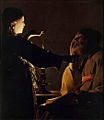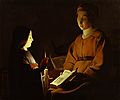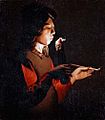Georges de La Tour facts for kids
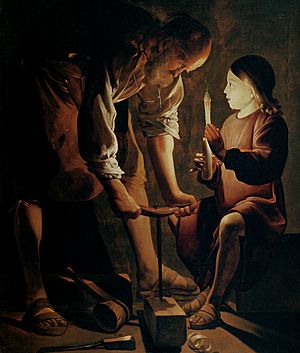
Georges de La Tour (born March 13, 1593 – died January 30, 1652) was a famous French painter. He lived most of his life in a region called Duchy of Lorraine. This area was sometimes part of France and sometimes part of the Holy Roman Empire (which was like a big group of states in Central Europe). La Tour was known for painting religious scenes. He often used a special lighting style called chiaroscuro, where parts of the painting are very bright and others are very dark, often lit by candlelight.
About His Life
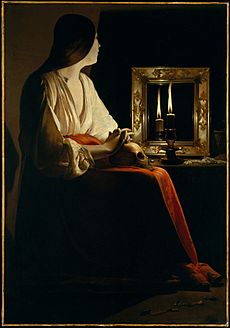
Georges de La Tour was born in a town called Vic-sur-Seille. His father, Jean de La Tour, was a baker. His mother was Sybille de La Tour. Georges was the second of their seven children.
We don't know much about his early art training. But it's thought that he traveled to Italy or the Netherlands. These places were important for art at the time. He might have learned from other artists there. His paintings show a style called Baroque naturalism. This means his art looked very real, like photos. This style was also used by a famous Italian artist named Caravaggio. La Tour's work is often compared to the Dutch painter Hendrick Terbrugghen.
In 1617, Georges de La Tour married Diane Le Nerf. She came from a noble family. In 1620, he set up his art studio in her hometown of Lunéville. This town was in the Duchy of Lorraine. He mostly painted religious scenes and some everyday life scenes. In 1638, he was given the special title "Painter to the King" of France. He also worked for the Dukes of Lorraine. But most of his customers were local wealthy people. He became quite rich from his art.
Georges de La Tour and his family died in 1652. They passed away during an epidemic in Lunéville. His son, Étienne, born in 1621, also became a painter and learned from his father.
His Artworks

La Tour's early paintings show influences from Caravaggio. He also painted scenes of tricksters and beggars. These early works are believed to be from the start of his career.
La Tour is most famous for his unique use of light at night. He made this style much more advanced than other artists. He used this special lighting in his religious paintings. Unlike Caravaggio, La Tour's religious art is less dramatic. He used a technique called chiaroscuro. This means he used strong contrasts between light and dark. His paintings also had simple shapes and clear designs. As he got older, his art became even simpler and calmer.
He often painted different versions of the same subjects. Not many of his paintings have survived to today. It can be hard to tell his work apart from his son Étienne's. For example, the painting Education of the Virgin in the Frick Collection in New York might be by either of them. Some other paintings, which are very skilled but have a different style, are thought to be by an unknown artist called the "Hurdy-gurdy Master." These paintings usually show older men, often alone, who are either beggars or saints.
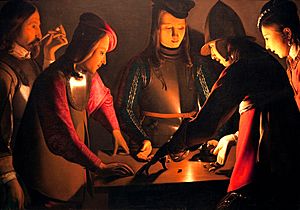
After Georges de La Tour died in 1652, his art was mostly forgotten. Then, in 1915, a German scholar named Hermann Voss rediscovered his work. Before that, some of La Tour's paintings were even thought to be by another famous Dutch artist, Johannes Vermeer.
In Movies
The director Peter Greenaway said that La Tour's art greatly influenced his 1982 film The Draughtsman's Contract.
La Tour's painting Job Mocked by His Wife appears in the 2003 French film Le Dîner de Cons.
A painting supposedly by La Tour is important in the 2003 film Le Divorce.
The painting Magdalene with the Smoking Flame is shown in Disney's 1989 film The Little Mermaid. It's in Ariel's grotto when she sings "Part of Your World" and wonders about fire.
Images for kids
-
Magdalene with the Smoking Flame, c. 1640, Los Angeles County Museum of Art
-
St Sebastian tended by St Irene, 1649, Parish Broglie France
-
Nativity, 1644, Louvre
-
The denial of Saint Peter, 1651, The Metropolitan Museum of Art
-
The education of the Virgin, c. 1650, The Frick Collection
-
The Repentant Magdalene, c. 1635-1640, National Gallery of Art
-
The Cheat with the Ace of Clubs, c. late 1620s, Kimbell Art Museum, Fort Worth, Texas. Another version (with Diamonds and slightly different clothes) is in the Louvre.
-
The Fortune Teller, 1633–1639, Metropolitan Museum of Art
-
The Hurdy-Gurdy Player, c. 1610–1630, Prado Museum
-
Portrait of an Old Man, c. 1624–1650, De Young Museum, San Francisco
-
St Jerome, c. 1630–1632, Nationalmuseum, Stockholm
See also
 In Spanish: Georges de La Tour para niños
In Spanish: Georges de La Tour para niños





